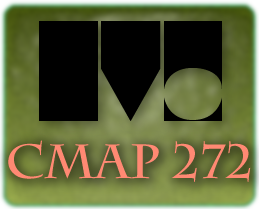Welcome
Welcome to John Coliton's CMAP272 "Professional Web Site Development" course web site. On this site I hope to provide resources to help you to successfully complete the course.
This site will...
- provide additional information that will help you be successful in the course,
- provide a syllabus in both HTML and PDF format (the later is suitable for printing),
- provide pictures of what each homework assignment should look like once complete,
- provide links to pages identified by other students as particularly interesting,
- provide links to pages and resources I think are particularly useful, and
- provide copies of all of the handouts given in class.
This site will not...
- replace buying the books (a requirement),
- replace reading the books (also a requirement),
- replace practicing with the books (yep, also a requirement), or
- replace doing homework (you get the idea).
I'm hoping to provide all of the extras you need to do well in this course, and that you choose to come back often to see what is new.
Site Construction Information
Since this course is about building web sites it seems only reasonable to talk about how this site was built. It was built in Dreamweaver, and uses tools provided by Adobe for building professional web sites. The general page format is from a layout called "1 column, liquid, centered, header and footer." The navigation across the top of the page utilizes a bulleted list and some fancy footward with Cascading Style Sheets to display the list as a horizontal menu bar (a technique we will be exploring in this class). The homework page uses a technology known as spry widgets, was downloaded from the Adobe web site, and is called a "Spry Content Slideshow" to show samples of each homework assignment and talk a little bit about the assignment. Spry is Adobe's term for a technology known as "AJAX," which stands for "Asynchronous JavaScript and XML" which is fortunately much easier to use (in Dreamweaver) than it is to explain. I'm including these features so you have a chance to see a few samples of the kinds of technology that can be included in a web page. HTML has come a long way since it was first used to link together research papers!
I hope you find this course interesting, the technology useful, and the adventure worth taking. I look forward to seeing you in class and talking more about what can be done with Dreamweaver, HTML, and CSS.
